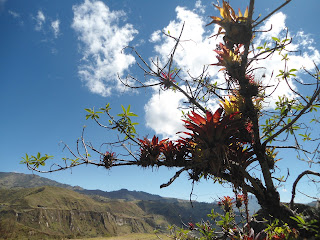 |
| Before the climb |
 |
| During the skills section; practicing using cramp ons, and ice picks |
 |
| playing around with the ice picks NOTE: you don't need to climb like this @ Cotopaxi |
 This trek was a struggle for me from the beginning. I didn't sleep a wink the night before (as I tried going to sleep at 8pm, knowing I had to wake up at midnight to start this trek). I was nervous/yet excited for the climb, so I started walking on no sleep. I could feel the effects right away. Martin and Ben were paired with another guide, since they walked faster then me. After about an hour into the hike, Ben decided it was smart to slow down, and joined Sergio (my guide) & I. Altitude is something you don't want to mess with. Tied to a rope, with our cramp ons, ice picks, and hiking sticks, we (well mostly just me, and because we were all tied together, the other 2 were forced to do so too) took about 10 slow steps, then took a small break. 10 more steps, then another small break.
This trek was a struggle for me from the beginning. I didn't sleep a wink the night before (as I tried going to sleep at 8pm, knowing I had to wake up at midnight to start this trek). I was nervous/yet excited for the climb, so I started walking on no sleep. I could feel the effects right away. Martin and Ben were paired with another guide, since they walked faster then me. After about an hour into the hike, Ben decided it was smart to slow down, and joined Sergio (my guide) & I. Altitude is something you don't want to mess with. Tied to a rope, with our cramp ons, ice picks, and hiking sticks, we (well mostly just me, and because we were all tied together, the other 2 were forced to do so too) took about 10 slow steps, then took a small break. 10 more steps, then another small break.
There were times, I would just collapse. My strength wasn't good enough to handle walking up a mountain of ice & snow, with 30 mph winds. Not having any sleep the night before certainly didn't help either. From the start, I was feeling the effects of the altitude (nausea & dizziness), but I kept motivating myself... "I"m getting to the top of that mountain!" Of course, I was freezing cold on top of that, but I figured the sun will eventually come up and warm our freezing cold bodies, so that won't be a problem.
After about 4 and a half hours of walking, we arrived at 5,400 meters. Ben & I just collapsed down to take a break and catch our breath. We discussed if this suffering is even worth it. The wind, the lack of sleep, the cold, and the feelings of altitude sickness. We only had about 500 meters to go (which would be another 2-3 hours). We just couldn't do it. We both admitted there were times where we could just cry it was so unbearable. We reached base camp, and our friend Martin was still out on the mountain. We assumed he reached the summit (as we later learned, he did). The 3 of us all agreed it was the most difficult thing (physically) that any of us has ever done (mainly because of the wind). Martin said, he couldn't even see a thing at the summit, not even the crater, because of the strong winds.
 |
| feeling defeated; walking back down the mountain |
It was still a wonderful experience for me. I have never challenged my body this hard before. It is often rare that I "give up", as well. It was interesting to see just how much I could push myself, before throwing in the towel.
Also, it shows, mother earth, wins. The power of mother earth is sometimes underestimated. She is stronger, bigger, and more powerful then any of us and we just can't compete. It was not my time to be on the top of the world's most active volcano. Cotopaxi, you will remain on my bucket list.





















































